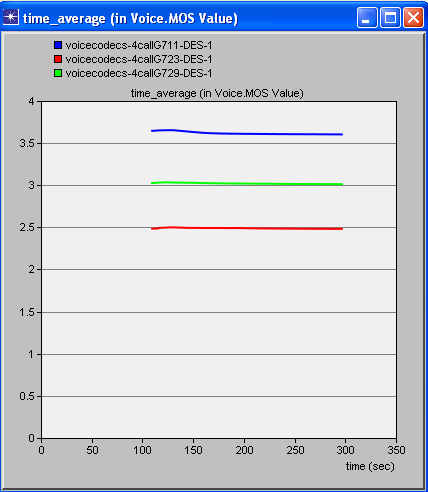Study the Performance of Various VoIP Codecs in WiMAX Network
Abdusalam Yahya1, Ahmed Mohammed Omar2
Elmergib University, Faculty of IT , Libya. E-Mail: abdusalamabduallahyahya74@gmail.com
2 Elmergib University,Faculty of Engineering . Libya. E-Mail: amaesheebah@elmergib.edu.ly
HNSJ, 2024, 5(11); https://doi.org/10.53796/hnsj511/31
Published at 01/11/2024 Accepted at 05/10/2024
Citation Methods
Abstract
Abstract: Worldwide Interoperability for Microwave Access (WiMAX) is a model of Wireless Metropolitan Area Networks. Many modern applications, such as Voice over Internet Protocol (VoIP), can be deployed over WiMAX. To transmit voice signals using Internet Protocol, a codec is used to convert analogue voice signals to digital format. This study aims to investigate the impact of different codecs (G.711, G.723, and G.729) on the Quality of Service (QoS) of VoIP in WiMAX. Optimized Network Engineering Tool (OPNET) Modeller 14 was selected for this study. The metrics used to evaluate VoIP performance were Jitter average delay and Mean Opinion Score. The results demonstrate that G.729 and G.711 codecs have a similar impact on VoIP performance. In contrast, the G.723 codec exhibited the worst performance.
Key Words: WiMAX, VoIP, Codecs.
INTRODUCTION
Based on the coverage area and the signal distance, wireless networks can be categorized into four classes: Wireless Personal Area Networks (WPAN), Wireless Local Area Networks (WLAN), Wireless Metropolitan Area Networks (WMAN) and Wireless Wide Area Networks (WWANs). Figure 1 presents these four types [1].In October 2004, the Institute of Electrical and Electronics Engineers (IEEE) proposed WiMAX by 802.16 standards. WiMAX is designed to serve many users in a vast geographic region at a meagre cost[2]. There are two types of this network: fixed (802.16d) and mobile (802.16e) [2]. The 802.16 network architecture is similar to the cellular telephone networks. One base station (BS) and one or more subscriber stations make up each 802.16 coverage area (SSs). BS connects the WiMAX network with core networks, whereas the subscriber station connects end users [3]. According to the 802.16 standers, WiMAX consists of media access control (MAC) and a physical layer (PHY). ATM and Ethernet traffic is expected to be transmitted via 802.16 networks [4].
VoIP is a technology that includes applications for providing voice communication service and multimedia over IP networks such as the Internet. IP telephony and Internet telephone are other names for this application. In contrast with traditional Public Switch Telephony Networks (PSTN), the key advantages of carrying voice-over IP networks are cost-saving and efficiency improvement [4]. The fundamental of VoIP involves digitizing analogue voice and delivering it across the Internet or any other IP-based network in the form of IP packets. On the sending side, an input device like a microphone is applied. The input signal is sampled at a very high rate and changed into digital form by an analogue-to-digital converter (A/C). Voice codec is employed to transform from analogue to digital format. The obtained data from (A/C) is compressed into microscopic samples, combined into large portions, and placed into IP packets for sending across the IP network. A single IP packet typically includes ten milliseconds or more of audio; however, 20 or 30 milliseconds is the most common. This procedure is called packetization. Codec compresses and de- compresses digital voice samples[5, 6].VoIP relies on various codecs to compress and de-compress audio samples. Every codec uses a different method and has a unique payload, frame size, speed, and delay, as shown in Table 1[7, 8]. In 1972 G.711 codec was developed to work in digital telephone technologies like integrated service digital network (ISDN), T1 and E1 links. The formal name of this code is Pulse code modulation (PCM) of voice frequencies. It has relatively low CPU needs and is the standard for all vendors. This codec digitizes 64 Kbps without compressing it and works best on local networks with enough bandwidth. Thus there is no license to use this codec [9, 10].G.723 codec is utilized for voice and video conferencing though its voice quality is lower. It has two-bit rates: 5.3 Kbps and 6.3 Kbps, and employs the Algebraic Code Excited Linear Prediction (ACELP). The codec works on a voice frame of 30 ms matching 240 samples. It is considered one of the licensed codecs, and it encodes and decodes speech at the rate of 8 kbps.G.729 operates based on CSACELP (Code-Excited Linear Prediction Speech Coding )codec and runs on 10ms frames[12, 13]. At a sampling rate of 8000 KHz and a complete delay of 37.5 ms [11].G.729 was primarily developed to deliver good voice call quality over a wireless environment.
The goal of this study is to examine the performance of G.711, G.729 and G.728 codecs over Wmax Network. And I identify the best codec for VoIP
PREVIOUS STUDY
The authors of [17] examined VoIP and video traffic over WiMAX using OPNET modeller 14.5. They analyzed delay and Jitter. The result of the study concluded that the delay parameter was increased when the number of mobile nodes was increased while Jitter levelled off. The researchers in [15] investigated the effect of service classes’ maximum sustained and minimum reserved values on the VoIP application. OPNET modeller was utilized to conduct the experiment part. The study results demonstrated that lowering the reserved bandwidth value improved QoS parameters in terms of throughput and sent-received traffics, but there was only slight improvement in term of end –to- end delay (E2E) and MOS. In [18] performance of VoIP over WiMAX was studied and analyzed using OPNET 14.5. The result concluded that UGS is more appropriate for VoIP as it provides the best performance. Furthermore, the results revealed that the G.723.1 codec had a reduced latency, greater MOS, and low bandwidth usage, making it superior to the G.711 and G.729A codecs. Researchers in [19] analyzed the performances of voice quality in terms of E2E delay, Jitter and packet loss in UMTS and WiMAX networks. VoIP was overloaded with HTTP traffic on the UMTS network, while VoIP was congested with a mix of traffic on the WiMAX network, including HTTP, Email, FTP, and Video Conferencing. According to the results, when VoIP was loaded with low and medium HTTP traffic, the UMTS network performed well in terms of E2E delay, Jitter, and packet loss. When VoIP is loaded with low, medium, and high HTTP in a WiMAX
network, E2E delay, Jitter, and packet loss remain unaffected. When VoIP is used with HTTP, Email, and FTP over WiMAX, the E2E time is dramatically increased, although jitter and packet loss are minimal. However, when VoIP was combined with HTTP, Email, FTP, and Video Conferencing, the E2E delay, Jitter, and packet loss were extremely high, indicating poor performance and dissatisfaction with QoS. Furthermore, performance was poor when VoIP was combined with a large amount of HTTP traffic. The study presented in [4] analyzed the performance of VoIP codec performance over a fixed WiMAX network. The study considers G.711, G.723, G.728, and G.729. MOS, E2E delay, Jitter and packet delay variation of VoIP were determined. OPNET simulation results revealed the optimum codecs for VoIP are G.729 and G.728.
METHODOLOGY
OPNET modeler 14.5 was utilized to conduct the experiment part of this study. OPNET is One of the most efficient simulation tools, which can simulate the behavior of wireless networks in the actual world, including WIMAX. Figure shows the experiment model
The model was composed of one base station, four subscriber stations and one server. Application Definition object was used to generate VoIP traffic over the model, and profile definition was used to assign VoIP traffic to the nodes. Three scenarios were conducted. G.711, G.723, and G.729codecs were
individually configured in the model. For the WiMAX network, the configurations for the three scenarios were the default settings. Only the number of voice calls was different as follows:
- One voice call in the first scenario.
- Two voice calls in the second test.
- Four voice calls in the third setup.
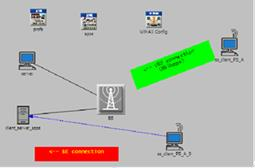
Fig1: Experiment Modul
A. Performance Metrics
Three QoS parameters were considered: Packet delay variation, delay and MOS. Packet delay variation (Jitter): is a critical factor in network performance deterioration and impacts user experience [4]. For voice packets jitter of 75 milliseconds (0.075 sec) is acceptable, whereas 40 milliseconds (0.040 sec) is desirable [20]. Delay: the time it takes for a packet to transmit from a source node to a destination node over the network. A voice call can accept a maximum of 150 milliseconds (0.15 sec) of latency in one direction, while 100 milliseconds is recommended (0.10 sec) [20]. The processing, queuing, serialization, and propagation delays are examples of network delays [21]. Mean Opinion Score (MOS): The International Telecommunication Union (ITU) has described the rating of opinions as the “value on a predefined scale that a subject assign to his opinion of the performance of a system”[22, 23].
B. Experiment Scenarios: Following are the results in the form of graphs for the
A) Experiment 1: one voice call
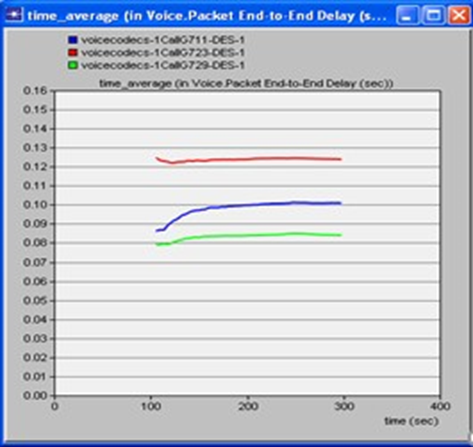
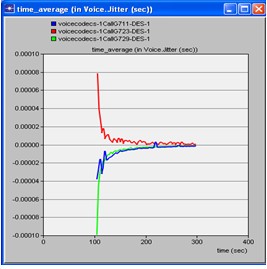
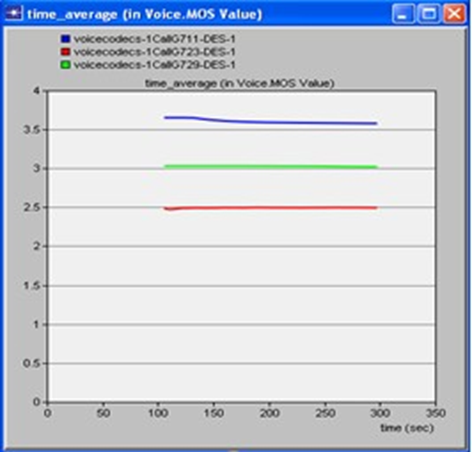 a
a
) VoIP Jitter b) VoIP Delay
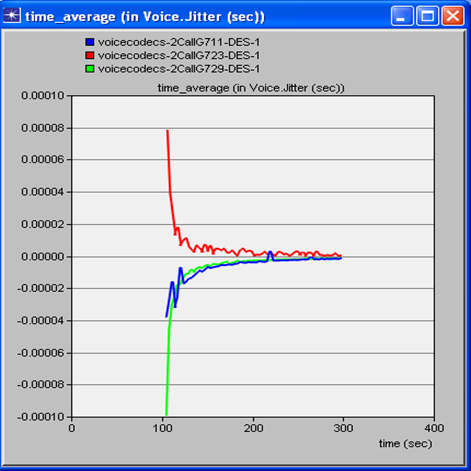
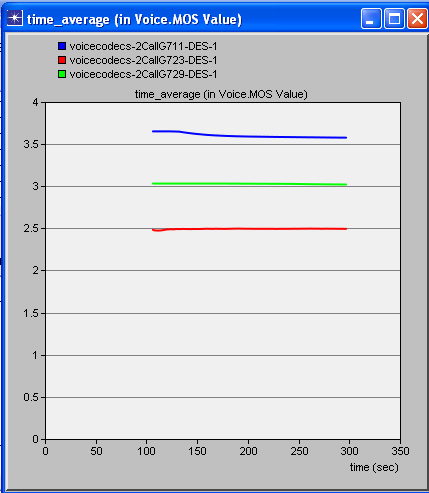
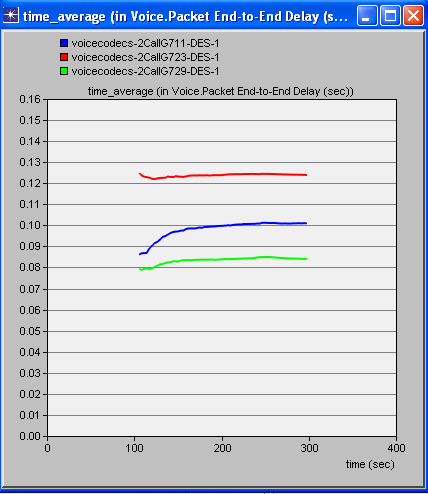
MOS of VoIP a) VoIP Jitter
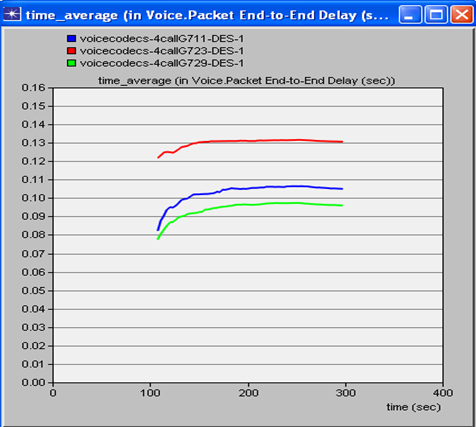
C) Experiment Three: Four Voice Call
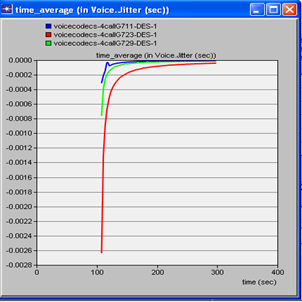
(b) VoIP MOS c) VoIP Delay
RESULT AND DISCUSSION
To get a clear result from this study, quantitative analysis was done as follows: First, data collected in the form of graphs from OPNET was exported to an excel sheet. Then, the average value for each VoIP metric was calculated using the built-in excel average function. Lastly, a table format was used to show the collected data.
A. One call test: Table 2 displays the performance of VoIP in the three Codecs.
Table 2: VoIP Performance in One call
| Codec | Jitter | Delay | MOS |
| G.711 | -0.00000065 | 0.09819 | 3.6 |
| G.723 | 0.0000056 | 0.12376 | 2.4 |
| G.729 | -0.00000007 | 0.08336 | 3.02 |
Based on table 2, it is clear that G.723 causes the highest VoIP delay at 0.123 seconds. In contrast, the delay was almost equal at 0.1 seconds in the case of G.711 and G.729.Additionally, while G.711 has the best MOS at 3.6, G.723 has the lowest MOS value at 2.4. However, the MOS was at 3.02 in G.723. Finally, the Jitter value was below zero for all codecs.
B.Two call tests: Table 3 offers the average collected data for the impact of the used codecs on VoIP performance.
Table 3: VoIP Performance in Two Calls
| Codec | Jitter | Delay | MOS |
| G.711 | -0.00000065 | 0.09819 | 3.601 |
| G.723 | 0.000000516 | 0.123768 | 2.493 |
| G.729 | -0.00000007 | 0.083368 | 3.02 |
Overall, the performance metrics in G.711 and G.729 had a similar pattern in which there were slight differences between the delay, Jitter and MOS. In Contrastingly, the highest level of Jitter, delay and MOS was in the G.723 codec.
C. For the four-call test, table 4 illustrates the effect of G.711, G.723 and G.729 on the quality of VoIP.
Table 4: VoIP Performance in Four Calls
| Codec | Jitter | Delay | MOS |
| G.711 | -0.0000025 | 0.103 | 3.62 |
| G.723 | -0.00002 | 0.131 | 2.9 |
| G.729 | -0.0000056 | 0.09429 | 3.02 |
Table 4 data shows that the value of voice jitter was less than zero (sec) for the three codecs. In addition, the majority of VoIP delay, Jitter and the lowest MOS value were from G.723.In addition. The record of voice delay for G.729 was almost 0.094 sec, while it was 0.103 sec in G.711.
CONCLUSION
In this study, the influence of G.711, G.729 and G.723 on VoIP was evaluated in the WiMAX platform. The assessment process was carried out using OPNET modular 14.5. Jitter, delay and MOS value of voice packet were calculated .in terms of Jitter, the performance of the three codecs was under zero sec. Concerning voice delay, G.723 has the highest value. The lowest value was in the case of G.729 and G.711. In terms of MOS, G.711 has the best value, and the worst value was in the case of G.723.Based on the outcome of this paper, the best codec for QoS of VoIP was G.729 and G.711, while the worst was f G.723
.REFERENCES
[1]J. Salazar Soler, “Wireless networks,” ed: European Virtual Learning Platform for Electrical and Information Engineering, 2017.
[2] N. B. Mohamadwasel, M. A. J. I. J. o. A. M. E. E. C. S. Abdala, and C. Systems, “Design of WiMAX Network for Istanbul Universities With OPNET,” vol. 1, no. 1, pp. 1-9, 2020.
[3]S. A. Ahson and M. Ilyas, WiMAX: applications. CRC press, 2018.
[4]F. M. S. Mohammed, A. B. A. A. J. I. J. o. C. Mustafa, and E. Engineering, “Voice over IP Codec at WiMAX Network (Analysis & Performance),” 2018.
[5]T. Chakraborty, I. S. Misra, and R. Prasad, “Overview of VoIP technology,” in VoIP Technology: Applications and Challenges: Springer, 2019, pp. 1-24.
[6]B. J. P. o. t. I. Goode, “Voice over internet protocol (VoIP),” vol. 90, no. 9, pp. 1495-1517, 2002.
[7]H. Sathu, M. A. J. I. J. o. e.-E. Shah, e-Business, e- Management, and e-Learning, “Performance comparison of VoIP codecs on multiple operating systems using IPv4 and IPv6,” vol. 2, no. 2, p. 122, 2012.
[8]A. M. J. a. p. a. Alsahlany, “Performance analysis of VOIP traffic over integrating wireless LAN and WAN using different codecs,” 2014.
[9]D. Joshi, S. J. I. J. o. A. R. i. c. s. Jangale, and e. Engineering, “Analysis of VoIP traffic in WiMAX using NS2 simulator,” vol. 1, no. 2, pp. 109-114, 2012.
[10]T. Anouari and A. J. a. p. a. Haqiq, “Performance analysis of VoIP traffic in WiMAX using various service classes,” 2013.
[11]Y. Deng, X. Yu, Q. Yang, and J. Lu, “On Qos performance of different voice codecs over ad hoc networks in underground mines,” in Proceedings of the 33rd Chinese Control Conference, 2014, pp. 5521- 5526: IEEE.
[12]K. Y. Zergat, S.-A. Selouani, and A. Amrouche, “Feature Selection Applied to G. 729 Synthesized Speech for Automatic Speaker Recognition,” in 2018 IEEE 5th International Congress on Information Science and Technology (CiSt), 2018, pp. 178-182: IEEE.
[13]N. N. Alfaisaly, S. Q. Naeem, A. H. J. I. J. o. E. E. Neama, and C. Science, “Enhancement of WiMAX networks using OPNET modeler platform,” vol. 23, no. 3, pp. 1510-1519, 2021.
[14]F. De Rango, M. Tropea, P. Fazio, S. J. I. J. o. C. S. Marano, and N. Security, “Overview on VoIP: Subjective and objective measurement methods,” vol. 6, no. 1, pp. 140-153, 2006.
[15]A. I. Alghannam, A. J. J. o. E. S. Alhafid, and Technology, “Performance analysis of Unsolicited Grant Service (UGS) service class in WiMAX voip application,” vol. 15, no. 3, pp. 1481-1491, 2020.
[16]R. A. Talwalkar and M. Ilyas, “Analysis of quality of service (QoS) in WiMAX networks,” in 2008 16th IEEE International Conference on Networks, 2008, pp. 1-8: IEEE.
[17]W. A. Ibrahim and I. E. Abdallah, “Delay QoS of Video and Voice over IP at WiMAX Network.”
[18]I. K. Y. Dubi, R. C. J. I. J. o. A. C. S. Muniyandi, and Applications, “Performance Investigation of VoIP Over Mobile WiMAX Networks through OPNET Simulation,” vol. 10, pp. 148-152, 2019.
[19]O. A. Ishgeem, A. M. Abood, N. R. Abosata, H. A. Alzawam, and H. T. Haqaf, “Analysis and Evaluation QoS of VoIP over WiMAX and UMTS Networks,” in 2021 IEEE 1st International Maghreb Meeting of the Conference on Sciences and Techniques of Automatic Control and Computer Engineering MI-STA, 2021, pp. 787-793: IEEE.
[20]H. A. Mohammed, A. H. Ali, and H. J. J. a. p. a. Mohammed, “The affects of different queuing algorithms within the router on QoS VoIP application using OPNET,” 2013.
[21]A. Lazzez and T. J. a. p. a. Slimani, “Deployment of VoIP Technology: QoS Concerns,” 2013.
[22]I. J. I. T. U. R. Recommendation, RITP: Geneva, Switzerland, “Vocabulary for performance and quality of service,” 2006.
[23]R. C. Streijl, S. Winkler, and D. S. J. M. S. Hands, “Mean opinion score (MOS) revisited: methods and applications, limitations and alternatives,” vol. 22, no. 2, pp. 213-227, 2016.

